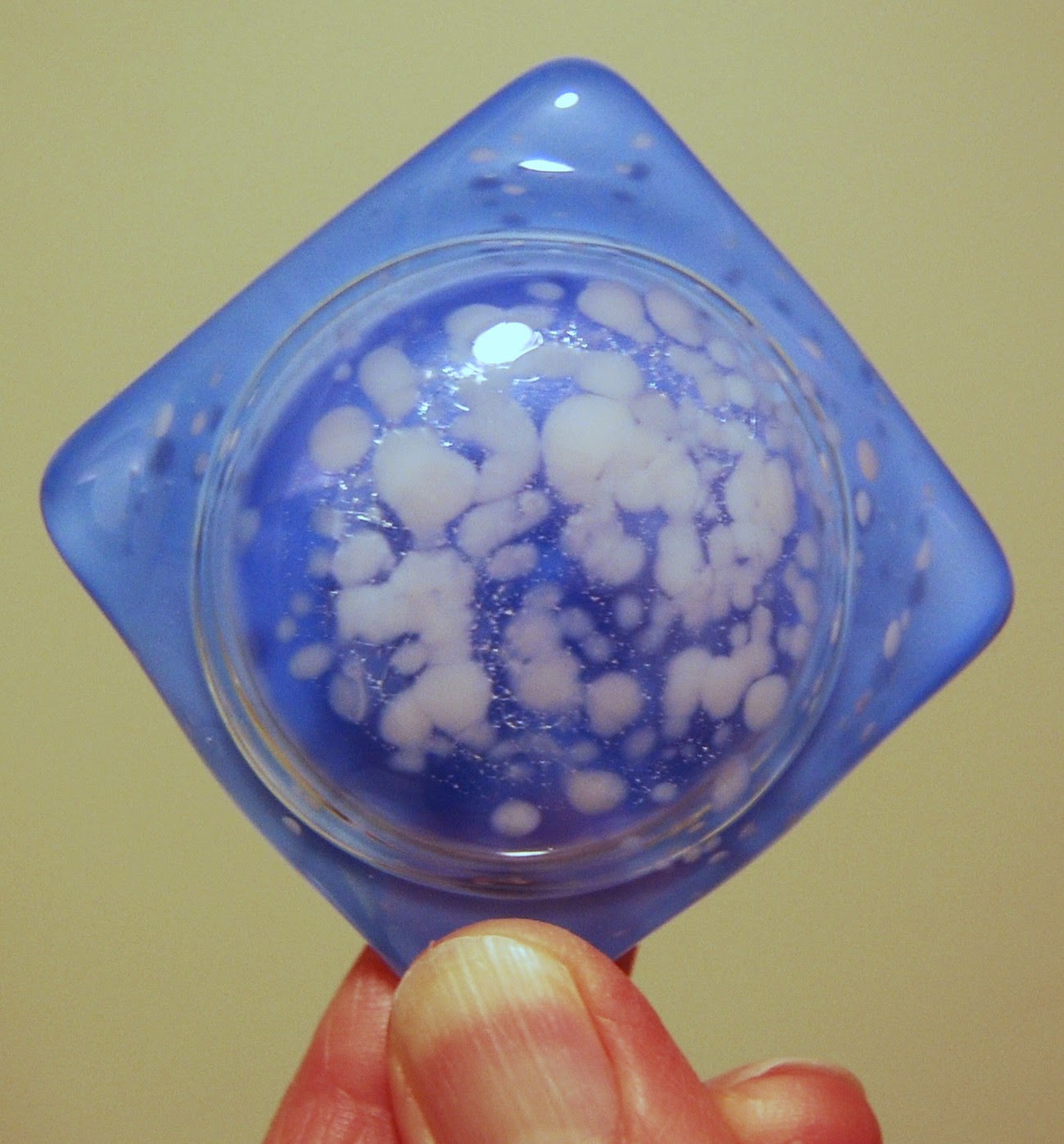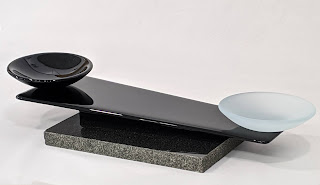2014 Magless Exchange - Bubbles!
 |
| 2014 magless exchange - Bubbles! |
Bubbles can be the proverbial bane of a fused glass artist's existence. Much care goes into eliminating bubbles from the finished piece. I have always been less concerned than I probably should be. I kind of LIKE bubbles, unless they are the huge, oh-my-goodness-something-went-terribly-wrong kind of bubbles.
As I pondered bubbles, I thought, "wouldn't it be cool if I could actually control those bubbles?". So I set out on these experiments.
We all know that any pocket of air in a piece is likely to create bubbles. I decided to intentionally create pockets in a controlled shape, and then accentuate the bubbles by using an off-gassing agent. You can purchase a commercial bubble powder made specifically for fused glass, and there are also bubble paints. But you can also use chemicals like baking soda and borax (the 20 Mule Team kind).
So... here are the basic how-tos for creating my controlled bubble maglesses:
 |
| Clear caps sprinkled with frit, ready for the first firing |
Cut ~ 1.25" rounds out of 1/8" fiber paper
Place squares on top of fiber paper rounds, place on prepared kiln shelf, and fuse
 |
| Fused clear cap, but edges not quite flat |
The firing schedule can be aggressive since these are small pieces, but it needs to be long enough and hot enough so that the outside edges of the completed piece will sit flatly on top of the base glass. This is a bad example (notice how the edges are raised). We'll find out why later!
Next, cut 2x2" squares of a base glass.
Remove fiber rounds from clear cap, clean
Mix baking soda & water, equal parts of each (a little goes a long way)
Using a small brush, paint a thin layer in the indention of the clear cap. I did not paint the entire indention, just the center.
Place caps on base glass, fire to full fuse.
 |
| Capped and ready for the kiln |
During the firing, watch carefully. When the pieces reach the desired height of the bubble, proceed to annealing. Note that if the bubble rises too much, it will be thin and fragile (I had one pop while cleaning that scared the wits out of me!).
As with most experiments, I didn't have complete success the first try. In fact, my first load of 49 maglesses (the ones seen in the "Capped and ready for the kiln" photo above) failed. The clear caps did not sit completely flat on the base, which allowed the gas to escape. I KNEW this going into the kiln, but told myself it wouldn't matter, that they would likely seal before the baking soda had completely off-gassed. Well, apparently, that theory was wrong!
Here are the results of some of my trial runs along the way. Note that most of these used dry baking soda except where noted. It resulted in a lovely bubble, but you can see the soda within.
 |
| Samples of different bubble experiments |
Failed batch - Yes, whether or not the cap sits flatly really does matter. I have 50 of these that have small, uncontrolled bubbles. I thinking they might be the beginning of a nice fountain. Bathroom tiles, anyone?
With inclusions - I really liked the result of putting small inclusions within the bubble space. The key here is that they are small enough not to touch the top. The small frit ball in the first example did touch, and it resulted in an interesting stretch of the frit ball, but attempts in creating something interesting with this resulted in the bubble failing to rise correctly.
Soda, dry - No inclusions, translucent base and clear cap. I love this, except for the soda.
Soda, with water - Soda mixed with water, painted on the piece. You can still see the soda; however, the key is to try to incorporate it into the design (aka, camouflage!).
No gas agent - Fused simply with the pre-fired clear cap. Nice, but I was hoping for a little more height to the bubble.
Borax - Reportedly, Borax works for creating bubbles. It didn't work for my purposes.
Mica, soda - Mica powder and dry soda. Even though you can see the soda if you look closely, and some of the mica powder moves around, I think it has potential.
 |
| Black opal glass bubble |
I enjoyed exploring this technique. While I am certain that it is not "new" (hasn't everything already been invented?) it was new to me. I had not seen it documented anywhere, so I'm glad to share my results here.
I have several ideas about how these controlled bubbles can be used to create interesting pieces. I also became so enamoured with bubbles that I purchased some Unique Glass Color artisan paints, which are formulated to create bubbles. I'm looking forward to experimenting with those, and perhaps exploring the results of combining those with this technique.
 |
| Maglesses! Time to wrap & ship! |
I hope you've enjoyed this post, and it helps to spark some ideas for your own bubble control. If you experiment with this technique, let me know how it goes!
Happy fusing,
Dana

